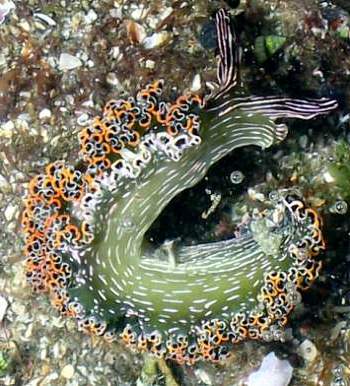
Elysia diomedea
(Bergh, 1894)
Order: SACOGLOSSA
Superfamily: ELYSIOIDEA
Family: Elysiidae
DISTRIBUTION
Pacific coast of central America. Found throughout the Gulf of Panama. Common in Gulf of California
PHOTO
Ecuador. Photo: Soledad Luna
Previously placed in the monotypic genus Tridachiella MacFarland, 1924. Very folded parapodial edge. Characteristic black and yellow lines on rhinophores. Grows to about 50mm in length, and found from the intertidal to about 20m.
It has long been considered related to the Caribbean E. crispata, first being described as a species of Tridachia [E. crispata was peviously in Tridachia], because of its extremely folded parapodia, and then placed in a subgenus, Tridachiella (MacFarland, 1924) because of the anterior gap separating the parapodia. The parapodia in E. diomedea are not joined anteriorly and branches of the digestive gland ramify into the sole of the foot causing green patches, similar to E. clarki. However, it differs considerably from E. clarki in colour and in having an extremely folded edge to the parapodia, as in E. crispata. Furthermore, while in E. clarki, the green on the sole of the foot is interspersed with rounded and oval whitish spots, in E. diomedea the translucent white regions are broken lines running parallel to the long axis of the body. Elysia diomedea also differs in having a characteristic pattern of black and white lines running down the rhinophores onto the head. Other differences in colour, compared to E. clarki, are the small blue spots scattered over the dorsum and inner walls of the parapodia, and a border of black spots, and sometimes red or orange spots, on the parapodial edge.
E. crispata, E. clarki and E. diomedea retain living chloroplasts which continue to photosynthesise within the body of the sea slug, providing it with sugars for its own nutrition. See the page on Solar powered sea slugs for further information. The process of taking chloroplasts from algal cells and keeping them has been given the name kleptoplasty
See separate message [#16728] comparing E. crispata, E. clarki and E. diomedea.
- Bergh, R. (1894) Reports on the dredging operations off the West Coast of Central America to the Galapagos, to the West Coast of Mexico, and in the Gulf of California, in charge of Alexander Agassiz, carried on by the U.S. Fish Commission Steamer "Albatross", during 1891, Lieut. Commander Z.L.Tanner, U.S.N., Commanding. XIII. Die Opisthobranchien. Bulletin of the Museum of Comparative Zoology 25(10): 125-233.
- Marcus, Ev. 1982 Systenatics of the genera of the Order Ascoglossa (Gastropoda). Supplement 10, Journal of Molluscan Studies: 1-31.
Rudman, W.B., 2006 (May 29) Elysia diomedea (Bergh, 1894). [In] Sea Slug Forum. Australian Museum, Sydney. Available from http://www.seaslugforum.net/factsheet/elysdiom
Related messages
-
Sea Slugs from Costa Rica
From: Victor Cespedes, March 24, 2010 -
Larval rearing in Elysia diomedea
From: Patrick Krug, September 23, 2008 -
Re: Elysia diomedea feeding requirements
From: Jake Weston, August 21, 2008 -
Re: Elysia diomedea feeding requirements
From: Jake Weston, August 19, 2008 -
Re: Elysia diomedea breeding in home aquarium
From: Skip Pierce, June 7, 2006 -
Elysia diomedea breeding in home aquarium
From: Matt Pedersen, June 5, 2006 -
Are these 'lettuce nudibranch' eggs?
From: Karen Hair, November 26, 2005 -
Elysia diomedea life span
From: Rebecca Rissanen, July 28, 2005 -
Elysia diomedea from the Sea of Cortez
From: Marli Wakeling, October 1, 2003 -
Elysia diomedea from Ecuador
From: Soledad Luna, August 21, 2003 -
Elysia diomedea from Mexico
From: José Luis Serrano, June 25, 2003 -
Elysia diomedea from Costa Rica
From: Peter Ajtai, June 2, 2002 -
How to raise Elysia crispata
From: Matt Galvin, December 19, 2001 -
Re: How to raise Elysia crispata
From: Erwin Koehler, December 19, 2001 -
Re: Elysia diomedea
From: Mary Jane Adams , June 9, 2001 -
Re: Elysia diomedea feeding requirements
From: Cynthia Trowbridge, June 7, 2001 -
Elysia diomedea feeding requirements
From: Sean, June 6, 2001
